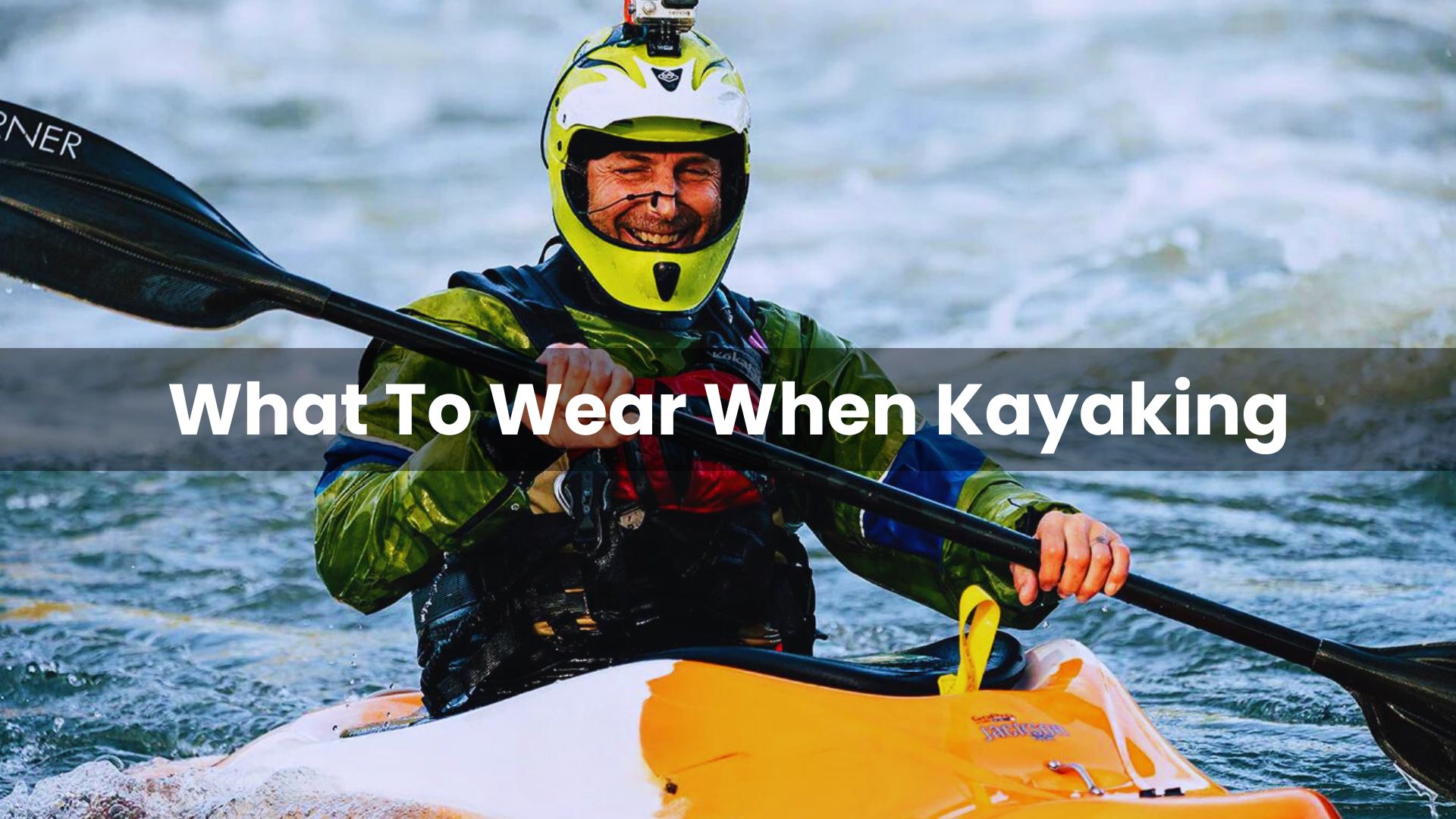Kayaking is an exhilarating outdoor activity that allows you to explore waterways and immerse yourself in nature. However, to fully enjoy your kayaking experience, it’s crucial to wear the right gear. The right clothing can keep you comfortable, dry, and safe throughout your adventure. In this comprehensive guide, we’ll cover everything you need to know about what to wear when kayaking, from essential clothing items to layering techniques and seasonal recommendations.
- Kayaking Clothing Essentials
- Factors to Consider When Choosing Kayaking Clothing
- Tips for Layering Kayaking Clothing
- Specific Clothing Recommendations for Different Seasons
- Footwear for Kayaking
- Safety Considerations
- What Are the Benefits of Wearing the Right Clothing When Kayaking?
- How to Care for Kayaking Clothing to Ensure Longevity?
- What Are Some Common Mistakes to Avoid When Choosing Kayaking Clothing?
- Conclusion
- Frequently Asked Question
Kayaking Clothing Essentials

When kayaking, wearing the proper attire is not just a matter of comfort; it’s a critical aspect of safety and performance. The right clothing can protect against the elements, help regulate body temperature, and even prevent hypothermia in colder waters.
Base Layer: The base layer is your first line of defense against the chill of the water and air. It should be made of moisture-wicking fabrics to keep you dry, as water can sap your body heat 25 times faster than air. Materials like synthetic fibers or merino wool are excellent choices for base layers because they transport moisture away from the skin, dry quickly, and maintain their insulating properties even when wet.
Mid Layer: The mid layer serves as the primary insulator. On colder days, this layer traps body heat to provide warmth. Materials such as fleece or down are popular for mid layers due to their excellent insulation properties. Fleece is particularly favored for its light weight and ability to retain heat even when damp.
Outer Layer: Your outer layer is your shield against wind and water. It’s essential to choose a waterproof and breathable material like neoprene or Gore-Tex. These materials keep water out while allowing sweat vapor to escape, ensuring that you stay dry from both external water and internal perspiration.
Accessories: Accessories might seem secondary, but they are vital in providing complete protection and comfort. A hat can shield you from the sun or provide warmth on cooler days. Gloves protect your hands from blisters and cold, while socks made of wool or neoprene can keep your feet warm even in chilly water.
Factors to Consider When Choosing Kayaking Clothing
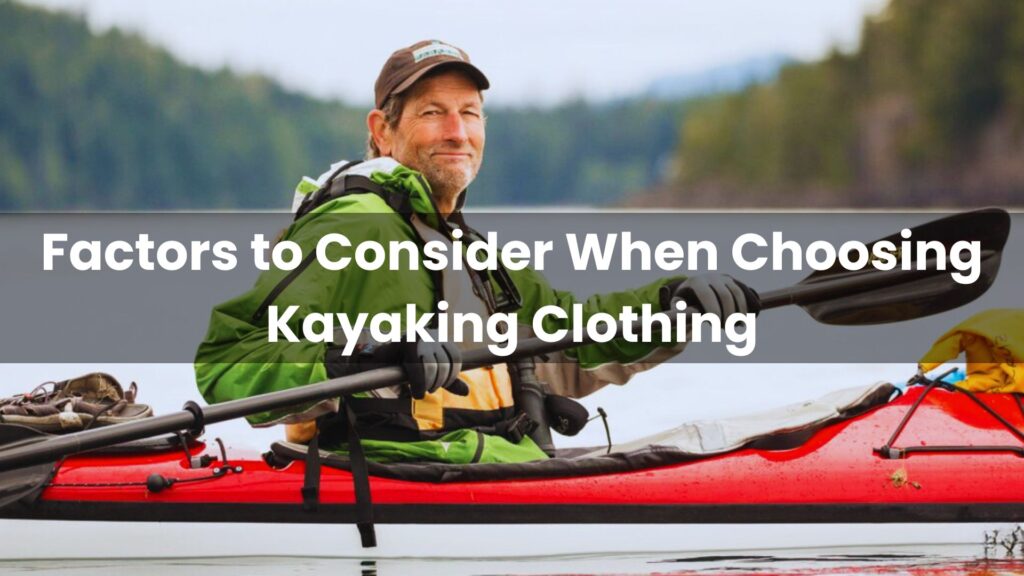
Selecting the right clothing for kayaking is a nuanced process that hinges on several key factors. These considerations ensure that your gear aligns with the conditions you’ll face and your personal needs, ultimately contributing to a successful and enjoyable outing on the water.
Weather Conditions: The weather plays a pivotal role in clothing selection. On sunny days, lightweight and breathable fabrics with UV protection are ideal. Conversely, colder, windier conditions necessitate layers that can shield you from the elements while retaining warmth.
Water Temperature: Water temperature is a critical factor, especially since it can differ significantly from the air temperature. If the water is cold, you’ll need insulating layers like neoprene or drysuits to prevent hypothermia. In warmer waters, lighter clothing may suffice, but always consider the risk of sudden immersion.
Duration of the Kayaking Trip: For longer trips, comfort and the ability to layer become more important. You’ll want clothing that can adapt to changing conditions throughout the day, as well as provide enough comfort to prevent chafing and discomfort over extended periods.
Type of Kayaking: The kayaking discipline influences your attire. Recreational kayaking in calm waters might only require simple, comfortable clothing, while whitewater or sea kayaking demands specialized gear like spray skirts and helmets for added safety.
Personal Preferences and Comfort: Finally, personal preference should not be overlooked. Some kayakers might prioritize flexibility and range of motion, while others might focus on maximum protection from the cold. Your comfort is paramount, as it will affect your stamina and overall experience.
Tips for Layering Kayaking Clothing
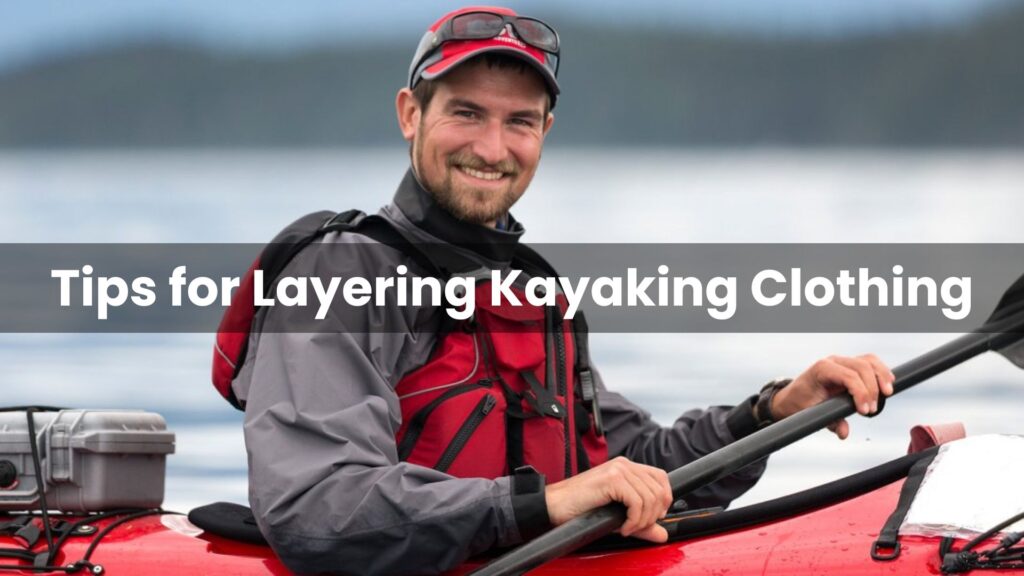
Layering is a strategic approach to dressing for kayaking that allows you to adapt to changing weather and water conditions. Here’s how to layer effectively:
Base Layer: Your base layer is your first line of defense against the elements and is crucial for moisture management. Opt for synthetic fabrics or merino wool that wick moisture away from your skin, keeping you dry and comfortable. Avoid cotton, as it retains moisture and can lead to hypothermia.
Middle Layer: The middle layer serves as insulation. Fleece or wool are excellent choices as they provide warmth even when wet. This layer should be snug but not restrictive, allowing for full range of motion as you paddle.
Outer Layer: The outer layer protects you from wind, rain, and splashes. A waterproof, breathable paddling jacket or dry top is ideal. Look for features like sealed seams, adjustable cuffs, and a waistband to prevent water entry.
Extremities: Don’t forget your hands, feet, and head. Neoprene gloves, water-resistant socks, and a hat are essential for staying warm. In colder conditions, consider a neoprene skull cap or balaclava.
Adaptability: Be prepared to shed or add layers as needed. Zippered garments and those with adjustable closures offer quick and easy modification to suit your comfort level.
Specific Clothing Recommendations for Different Seasons
When it comes to kayaking, the right clothing can make all the difference in your comfort and safety on the water. Here’s how to dress for success in any season:
Spring: Spring weather can be unpredictable, with chilly mornings and warmer afternoons. Layering is key. Start with a moisture-wicking base layer to keep you dry, add an insulating fleece or wool mid-layer, and top it off with a waterproof and windproof jacket. Neoprene gloves and socks can provide extra warmth without bulk.
Summer: In the summer, lightweight, breathable, and quick-drying clothes are essential. A long-sleeved shirt with UV protection will shield you from the sun’s rays, while a pair of board shorts or a quick-dry skirt can offer comfort and mobility. Don’t forget a wide-brimmed hat and sunglasses for sun protection, and consider a light spray jacket for unexpected showers.
Autumn: As temperatures drop, it’s important to stay warm without overheating. A thermal base layer paired with a fleece mid-layer will keep you cozy. Waterproof trousers and a paddling jacket with sealed seams will protect against splashes and rain. A hat and waterproof gloves will help retain body heat.
Winter: Winter demands the most protection. A drysuit is the best defense against cold water and air, allowing you to layer underneath as needed. Thermal base layers, thick socks, and insulated boots are a must. A woolly hat and waterproof gloves will prevent heat loss from your extremities.
Footwear for Kayaking
Selecting the right footwear is a pivotal aspect of kayaking attire. It not only protects your feet from the elements but also enhances your grip and stability within the kayak. Here’s what you need to know about choosing the best footwear for your paddling adventures:
Neoprene Booties: Neoprene booties are the go-to choice for most kayakers. They provide excellent insulation, keeping your feet warm in cold water conditions. Their snug fit ensures minimal water entry, and the reinforced soles offer protection against sharp rocks and slippery surfaces.
Water Shoes: For warmer climates or summer kayaking, water shoes are ideal. They are lightweight, drain water quickly, and dry fast. Look for shoes with a sturdy sole to protect against abrasion and a secure fit to prevent them from coming off in the water.
Sandals: If you’re paddling in calm, warm waters, sandals with a heel strap can be a comfortable option. They offer ventilation and are easy to slip on and off. However, they provide less protection, so they’re not recommended for rough conditions.
Specialized Kayaking Boots: For challenging environments and colder seasons, specialized kayaking boots offer the best protection. They are designed to handle rugged terrain, provide ankle support, and are made with materials that withstand extended exposure to water.
Socks: In colder conditions, wearing a pair of waterproof or neoprene socks can add an extra layer of warmth. They can be worn alone or with your chosen footwear to ensure your feet stay dry and comfortable throughout your journey.
When selecting footwear, consider the fit, comfort, and the specific conditions you’ll be kayaking in. Proper footwear not only keeps you comfortable but also contributes to your safety on the water.
Safety Considerations
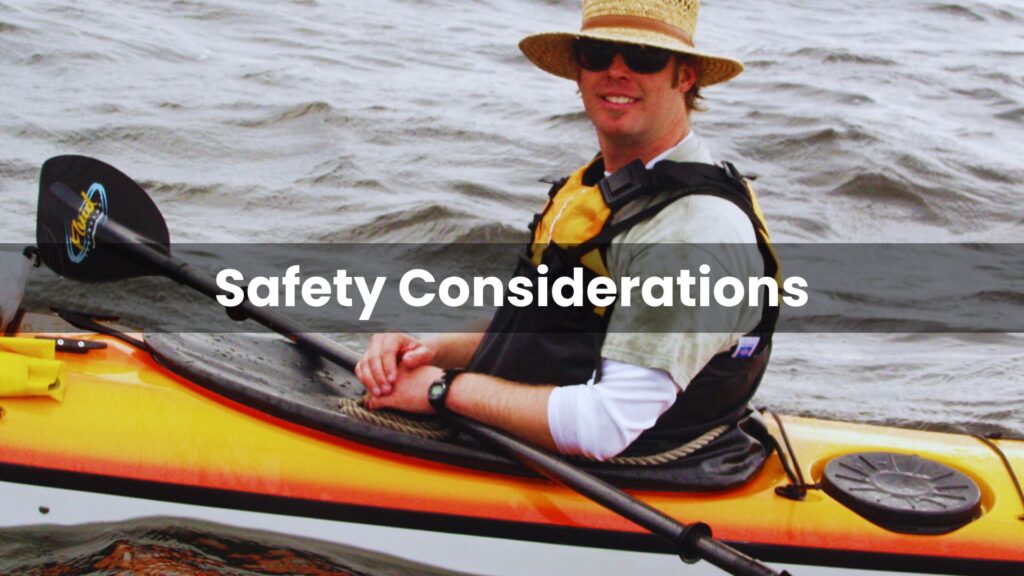
When preparing for a kayaking trip, safety should always be your top priority. The right clothing goes beyond comfort; it’s about ensuring you’re prepared for any situation that may arise. Here are some crucial safety considerations to keep in mind:
Personal Flotation Device (PFD): Always wear a PFD approved by the coast guard. It should fit snugly without restricting movement. PFDs not only keep you afloat but also provide extra insulation in cold weather.
Visibility: Choose bright colors for your clothing and PFD to ensure you are visible to other water users. High-visibility colors can be a lifesaver in the event of an emergency.
Protection from the Elements: Sun protection is vital. Wear a hat, sunglasses, and sunscreen to protect against UV rays. In colder climates, proper insulation and waterproof gear are essential to prevent hypothermia.
Dry Bag: Keep a dry bag with emergency gear, such as a whistle, flashlight, and first-aid kit. It’s also wise to pack extra food, water, and a change of clothes.
Know Your Limits: Dress for the water temperature, not just the air temperature, and be aware of your skill level. Avoid kayaking in conditions that are beyond your abilities.
Buddy System: Never kayak alone. Having a partner ensures that help is at hand if you encounter difficulties.
What Are the Benefits of Wearing the Right Clothing When Kayaking?
Kayaking is an exhilarating outdoor activity that allows you to explore waterways and immerse yourself in nature. However, to fully enjoy your kayaking experience, it’s crucial to wear the right gear. The right clothing can provide numerous benefits that enhance your safety, comfort, and overall enjoyment while on the water. Let’s explore the key benefits of wearing the appropriate clothing when kayaking:
Protection from the Elements
Kayaking often exposes you to various weather conditions, including rain, wind, sun, and changing temperatures. By wearing the right clothing, you can shield yourself from these elements and stay comfortable throughout your adventure. Proper clothing can protect you from harmful UV rays, prevent sunburn, and keep you warm and dry in colder conditions.
Watersport Safety
Choosing the right clothing is essential for safety while kayaking. Wearing inadequate layers or the wrong type of clothing can be hazardous, especially if you get wet. The right gear can prevent hypothermia and other risks associated with exposure to water. A properly fitted life jacket is a crucial safety item that should always be worn while on the water.
Comfort and Enjoyment
The right clothing can significantly impact your comfort and enjoyment while kayaking. Choosing moisture-wicking, breathable, and quick-drying materials can keep you dry, warm, and comfortable, allowing you to focus on enjoying the sport without distractions. Clothing that allows for freedom of movement is crucial for kayaking, as restrictive clothing can hinder your ability to paddle effectively and comfortably.
Preventing Body Temperature Fluctuations
Wearing appropriate clothing helps regulate your body temperature, preventing sudden drops in temperature that can occur when clothing gets wet. Layering your clothing and avoiding materials like cotton that retain moisture can help maintain a stable body temperature, ensuring you stay comfortable and focused on your kayaking adventure.
Enhanced Mobility
Clothing that allows for freedom of movement is crucial for kayaking. Restrictive clothing can hinder your ability to paddle effectively and comfortably. Choosing flexible and comfortable clothing ensures you can move freely while on the water, allowing you to navigate your kayak with ease and efficiency.
How to Care for Kayaking Clothing to Ensure Longevity?
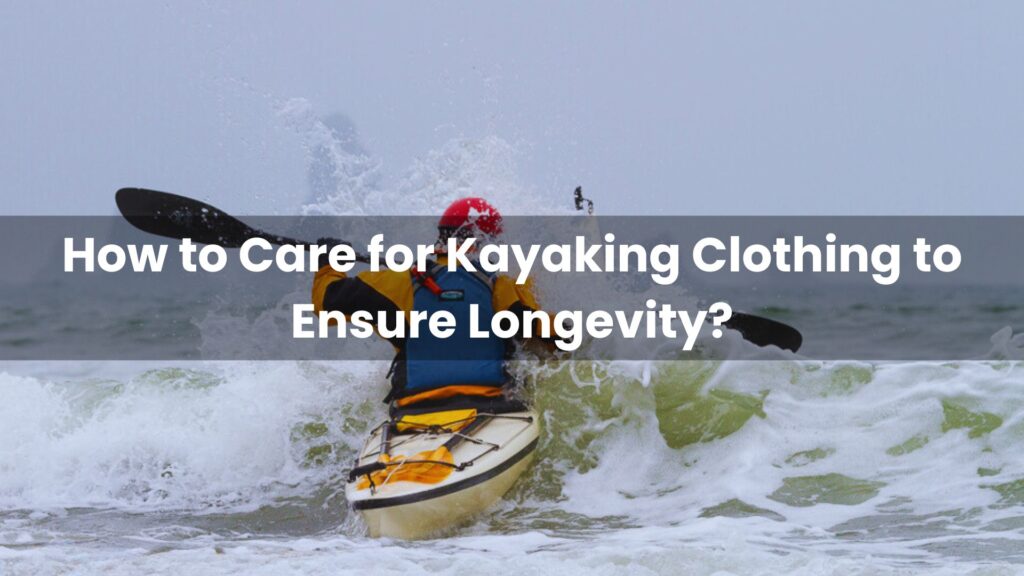
When it comes to kayaking clothing, investing in high-quality gear is only half the battle. To ensure your clothing lasts for many adventures to come, proper care and maintenance are crucial. Here are some expert tips on how to care for your kayaking clothing to extend its lifespan:
Washing Kayaking Clothing
After each use, inspect your clothing for any signs of dirt, salt, or other substances that may affect its performance. For most kayaking clothing, machine washing in cold water with a mild detergent is recommended. Avoid using fabric softener or bleach, as these can damage the water-repellent coatings or compromise the fabric’s breathability. For particularly stubborn stains, you can use a gentle cleaning product specifically designed for outdoor gear.
Drying Kayaking Clothing
Drying your kayaking clothing is just as important as washing it. To prevent mildew and bacterial growth, it’s essential to dry your gear quickly and thoroughly. For most clothing items, air drying is the best option. If you need to speed up the drying process, you can use a low-heat tumble dryer or a drying rack. Avoid direct sunlight, as it can cause colors to fade or fabrics to degrade.
Storing Kayaking Clothing
When not in use, store your kayaking clothing in a cool, dry place away from direct sunlight. Avoid folding or creasing your clothing, as this can cause damage to the fabric or coatings. Instead, hang your clothing or store it in a breathable bag to maintain its shape and prevent moisture buildup.
Re-Waterproofing Kayaking Clothing
Over time, the water-repellent coatings on your kayaking clothing may start to wear off. To restore the water-repellent properties, use a re-waterproofing treatment specifically designed for outdoor gear. Follow the manufacturer’s instructions for application, and make sure to test the treatment on an inconspicuous area first.
Inspection and Repair
Regularly inspect your kayaking clothing for signs of wear and tear, such as tears, holes, or frayed seams. Addressing these issues promptly can prevent them from becoming major problems. For minor repairs, you can use a needle and thread or a repair kit specifically designed for outdoor gear. For more extensive damage, consider consulting a professional seamstress or the manufacturer’s repair service.
What Are Some Common Mistakes to Avoid When Choosing Kayaking Clothing?
When it comes to choosing the right clothing for kayaking, there are several common mistakes that beginners and even experienced paddlers often make. Avoiding these mistakes can significantly enhance your overall kayaking experience, ensuring you stay comfortable, safe, and enjoy the time spent on the water.
Cotton is a No-Go
One of the most significant mistakes is wearing cotton clothing. Cotton absorbs water, making it heavy and cold when wet, which can lead to hypothermia in cold weather conditions. Instead, opt for synthetic or natural fibers like merino wool, polyester, or nylon that dry quickly and provide better insulation.
Dressing Too Warm
Another mistake is dressing too warmly, especially on hot days. Kayaking can be a physically demanding activity, and overdressing can lead to excessive sweating, which can make you colder when you stop paddling. Dress in layers to adjust to changing temperatures and activity levels.
Not Considering the Water Temperature
Failing to consider the water temperature is a critical mistake. If you’re kayaking in cold water, you’ll need clothing that provides adequate insulation and protection from the cold. In warmer waters, you may prefer lighter, breathable clothing.
Ignoring Sun and Wind Protection
Many kayakers underestimate the impact of the sun and wind on their skin. Failing to wear protective clothing, such as a hat, sunglasses, and sunscreen, can lead to sunburn, windburn, and skin damage.
Not Choosing Quick-Drying Clothing
Wearing clothing that doesn’t dry quickly can make you uncomfortable and even lead to hypothermia. Always opt for quick-drying clothing that can help you stay dry and warm.
Not Dressing for the Type of Kayaking
Different types of kayaking, such as whitewater or sea kayaking, require specific types of clothing. Failing to dress appropriately for the type of kayaking you’re doing can put you at risk of discomfort, injury, or even death.
These common mistakes can help ensure a safer, more enjoyable kayaking experience. Remember to dress appropriately for the water temperature, activity level, and the kayaking you’re doing, and always prefer quick-drying, breathable clothing that provides adequate protection from the elements.
Conclusion
kayaking offers an invigorating connection with nature and a thrilling way to traverse waterways. The key to maximizing your enjoyment and safety on the water lies in what to wear when kayaking. By choosing appropriate attire, you ensure comfort, dryness, and protection, allowing you to focus on the beauty and excitement of your journey. Remember to adapt your clothing to the weather, water conditions, and the duration of your trip. With the right gear, every kayaking adventure can be a memorable one, where the only thing you need to worry about is how much fun you’re having. So, suit up with the essentials, layer smartly, and paddle confidently into your next waterway exploration.
Frequently Asked Question
Can you wear jeans while kayaking?
No, jeans are not suitable for kayaking. Jeans absorb water and become heavy and uncomfortable when wet. It’s better to wear quick-drying pants or shorts designed for water sports.
Can you wear flip flops while kayaking?
No, flip flops or thongs are not ideal for kayaking. They can easily come off and be lost overboard. It’s better to wear water shoes, sandals, or paddling booties which provide more grip and protection for your feet.
Do you need a wetsuit for kayaking?
A wetsuit is highly recommended, especially when learning to kayak. It will keep you warm if you end up in the water, particularly in cold conditions. The type of wetsuit depends on water temperature – thicker suits for colder water.
What should you wear under a wetsuit?
You can wear swimwear or go commando under a wetsuit. Some people prefer loose-fitting clothes with swimwear underneath if planning to swim from the kayak.
What should you wear on your feet for kayaking?
Neoprene booties or water shoes are ideal footwear for kayaking. They provide warmth and grip. Closed-toe shoes help protect against stubbing your toes on rocks. Crocs are a popular choice for their ease of use and quick drying.
Do you get wet when kayaking?
Yes, you will get wet when kayaking. Unlike stand-up paddleboarding, there is no way to avoid getting wet as you sit lower in the water and get splashed. Wearing the right clothing to stay warm and comfortable is essential.

Nigel Foster, born in 1952, is an esteemed sea kayaker, known for being the youngest to kayak around Iceland. His journey in kayaking started at 15 in Brighton, England. With a career beginning as a trainee instructor in Sussex, he later pursued teaching after attending Redland College, Bristol.
Foster’s notable expeditions include navigating the challenging waters of Newfoundland and the Hudson Strait. Despite facing intense conditions, his passion for kayaking never waned. He holds several British Canoe Union qualifications and has significantly contributed to the kayaking community through teaching and committee work.
In 1985, Foster expanded his horizons by assisting an expedition in Iceland and later founded his own kayaking business, sharing his expertise globally.
